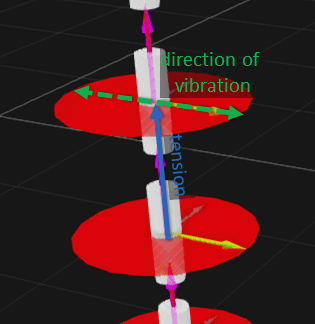Geometric Stiffness for Cables
Stable simulation of cables is a challenge since they often involve very small compliances and large mass ratios. Instability manifests as vibrations in the cable with motion perpendicular to the stiff axes of the cable constraints. For example, this typically occurs during instances of high tension. The figure shown below illustrates this phenomenon.
|
A method for preventing such instability is to apply damping to all cable constraints based on the amount of tension in the cable.
In Vortex®, cables can be stabilized using an adaptive technique based on the geometric stiffness. The geometric stiffness encodes the directions where instability may occur. This allows the cable to be damped automatically during instances of high tension or when the simulation involves large constraint forces. However, damping only occurs in directions that require it. This improves the overall quality of the cable simulation and gives better dynamical behavior.
To set up geometric stiffness:
- Select a Dynamics Generic Cable in the Explorer panel.
- In its Dynamics Generic Cable Properties panel, check the Geometric Stiffness Enabled box found under Parameters > Definition > Param Definition.
There are two parameters for tuning the geometric stiffness feature, Geometric Stiffness Stability Threshold and Geometric Stiffness Scale, which are described in Cable Systems Types.
